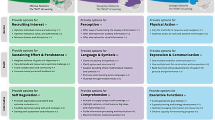Abstract
Designing for Universal Access requires designers to have a good understanding of the full range of users and their capabilities, appropriate datasets, and the most suitable tools and techniques. Education clearly plays an important role in helping designers acquire the knowledge and skills necessary to find the relevant information about the users and then apply it to produce a genuinely inclusive design. This paper presents a reflective analysis of a variant of the “Usability and Accessibility” course for MSc students, developed and delivered by the author over five successive semesters at the IT University of Copenhagen. The aim is to examine whether this course provided an effective and useful method for raising the issues around Universal Access with the designers of the future. This paper examines the results and conclusions from the students over five semesters of this course and provides an overview of the success of the different design and evaluation methods. The paper concludes with a discussion of the effectiveness of each of the specific methods, techniques and tools used in the course, both from design and education perspectives.

Similar content being viewed by others
References
ACM: ACM Special Interest Group on Computer Human Interaction: SIGCHI Conference Publications Format. http://www.sigchi.org/publications/chipubform (2014). (Accessed 25 Oct 2014)
Adlin, T., Pruitt, J.: The Essential Persona Lifecycle: Your Guide to Building and Using Personas. Morgan Kaufman, San Francisco (2010)
Bigham, J.P., Prince, C.M.: WebAnywhere: a screen reader on-the-go. In: Proceedings of the 9th International ACM SIGACCESS Conference on Computers and Accessibility, pp. 225–226 (2007)
Cambridge University Engineering Department (CUED): Inclusive Design—Exclusion Calculator. http://www.eng.cam.ac.uk/inclusivedesign/index.php?section=data&page=exclusion_calc (2005). (Accessed 25 Oct 2014)
Cambridge University Engineering Department (CUED): Inclusive Design Toolkit—Exclusion Calculator. http://www.inclusivedesigntoolkit.com/betterdesign2/exclusioncalc/exclusioncalc.html (2013). (Accessed 25 Oct 2014)
Clarkson, P.J., Coleman, R., Lebbon, C., Keates, S.: Inclusive Design—Designing for the Whole Population. Springer, London (2003)
Clarkson, P.J., Keates, S.: Quantifying design exclusion. In: Keates, S., Clarkson, P.J., Langdon, P.M., Robinson, P. (eds.) Universal Access and Assistive Technology, pp. 23–32. Springer, London (2002)
Cooper, A.: The Inmates are Running the Asylum. SAMS, Indianapolis (1999)
Follette Story, M.: The principles of universal design. In: Preiser, W., Ostroff, E. (eds.) Universal Design Handbook. McGraw-Hill, New York (2001)
Freedom Scientific: JAWS for Windows: Screen Reading Software. http://www.freedomscientific.com/Products/Blindness/JAWS (2014). (Accessed 25 Oct 2014)
Guardian: University Guide 2014: League Table for Computer Sciences and IT. http://www.theguardian.com/education/table/2013/jun/04/university-guide-computer-sciences-it (2014). (Accessed 25 Oct 2014)
Her Majesty’s Stationery Office (HMSO): UK Disability Discrimination Act 1995. http://www.legislation.gov.uk/ukpga/1995/50/contents (1995). (Accessed 25 Oct 2014)
HiSoftware: HiSoftware® Cynthia Says™ Portal. http://www.cynthiasays.com/ (2013). (Accessed 25 Oct 2014)
Hudson, W.: Playing your cards right: getting the most from card sorting for navigation design. Interactions 12(5), 56–58 (2005)
ISO: ISO 9241-11:1998 Ergonomic Requirements for Office Work with Visual Display Terminals (VDTs)—Part 11: Guidance on Usability. International Organization for Standardization, Geneva, CH (1998)
Keates, S., Clarkson, P.J.: Countering Design Exclusion—An Introduction to Inclusive Design. Springer, Heidelberg (2003)
Keates, S.: Designing for Accessibility: A Business Guide to Countering Design Exclusion. Lawrence Erlbaum, Mahwah (2007)
Keates, S., Adams, R., Bodine, C., Czaja, S., Gordon, W., Gregor, P., Hacker, E., Hanson, V., Kemp, J., Laff, M., Lewis, C., Pieper, M., Richards, J., Rose, D., Savidis, A., Schultz, G., Snayd, P., Trewin, S., Varker, P.: Cognitive and learning difficulties and how they affect access to IT systems. Int J Univers Access Inf Soc 5(4), 329–339 (2007)
Keates, S., Lebbon, C., Clarkson, P.J.: Investigating industry attitudes to universal design. In: Proceedings of the RESNA 2000 (Orlando, FL), pp. 276–278. RESNA Press, Arlignton, VA (2000)
Marcus, A.: Universal, ubiquitous, user-interface design for the disabled and elderly. Interactions 10(2), 23–27 (2003)
Newell, A.F., Gregor, P.: “User sensitive inclusive design”—in search of a new paradigm. In: Proceedings of the 2000 Conference on Universal Usability (CUU’00), pp. 39–44 (2000)
Nielsen, J.: Usability Engineering. Morgan Kaufman, San Francisco (1993)
Nielsen, J., Mack, R.L.: Usability Inspection Methods. Wiley, New York (1994)
Stephanidis, C.: The Universal Access Handbook, 1st edn. CRC Press, Boca Raton (2009)
Thatcher, J., Burks, M.R., Heilman, C., Henry, S.L., Kirkpatrick, A., Lauke, P.H., Lawson, B., Regan, B., Rutter, R., Urban, M., Waddell, C.D.: Web Accessibility: Web Standards and Regulatory Compliance. Springer, New York (2006)
US DoJ: US Department of Justice: Americans with Disabilities Act of 1990. http://www.ada.gov/pubs/ada.htm (1990). (Accessed 25 Oct 2014)
Vanderheiden, G., Tobias, J.: Universal design of consumer products: current industry practice and perceptions. In: Proceedings of the XIVth Triennial Congress of the International Ergonomics Association and 44th Annual Meeting of the Human Factors and Ergonomics Society, vol. 6, pp. 19–22 (2000)
Vischeck: Vischeck. http://www.vischeck.com/ (2008). (Accessed 25 Oct 2014)
Vredenburg, K., Mao, J.-Y., Smith, P.W., Carey, T.: A survey of user-centered design practice. In: Proceedings of the SIGCHI Conference on Human Factors in Computing Systems (CHI ‘02), pp. 471–478 (2002)
WebAIM: WAVE—Web Accessibility Evaluation Tool. http://wave.webaim.org/ (2014). (Accessed 25 Oct 2014)
Author information
Authors and Affiliations
Corresponding author
Rights and permissions
About this article
Cite this article
Keates, S. A pedagogical example of teaching Universal Access. Univ Access Inf Soc 14, 97–110 (2015). https://doi.org/10.1007/s10209-014-0398-4
Published:
Issue Date:
DOI: https://doi.org/10.1007/s10209-014-0398-4




